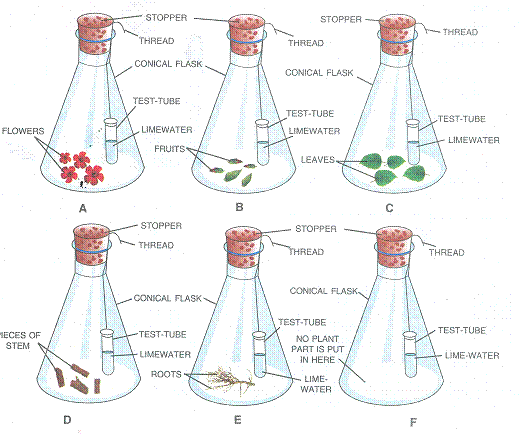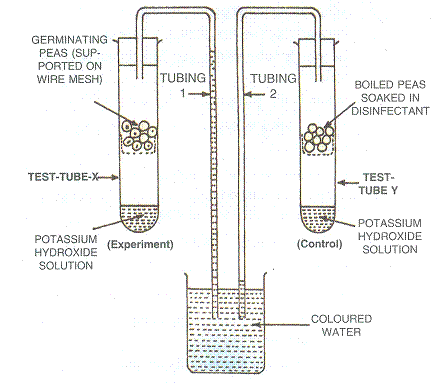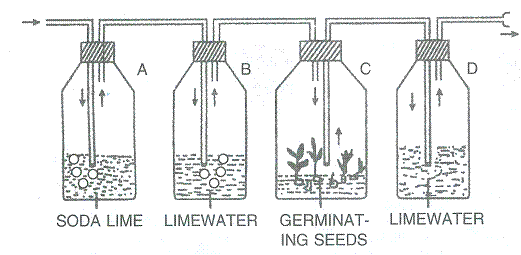Selina ICSE Solutions for Class 9 Biology Chapter 7 - Respiration in Plants
Exercise 1
A. Multiple Choice Question
1. Glycolysis is a process
(a) in which glycogen is broken down into glucose
(b) which occurs in mitochondria
(b) which occurs in mitochondria
(c) in which glucose is broken down into pyruvate
(d) that occurs next to Krebs cycle
2. One same common function is performed by?
(a) Stomata and veins
(b) Stomata and lenticels
(b) Stomata and lenticels
(c) Lenticels and sepals
(d) Lenticels and hydathodes
3. Anaerobic respiration normally occurs in
(a) Grass
(b) Cactus
(c) Coconut
(d) Baker's yeast
Solution A.
1. (c) in which glucose is broken down into pyruvate
2. (b) Stomata and lenticels
3. (d) Baker’s yeast
B. Very Short Answer Type.
1. Do the plants respire all day and all night or only at night?
Solution B.1.
Respiration is an essential life process for all living organisms. Therefore, plants also respire all day and all night.
2. Name the following:
(a) Energy currency of cell.
(b) Oxidative breakdown of carbohydrates to release energy.
(c) An organism which respires throughout life anaerobically
(d) A common phase in both aerobic and anaerobic respiration.
(e) Aerobic respiration requires_________ .
(f) A chemical which removes CO2 from the air.
Solution B.2.
(a) ATP
(b) Respiration
(c) Fungus
(d) Glycolysis
(e) Oxygen
(f) Soda lime
3. Mention if the following statements are true or false. If false, rewrite them correctly.
(a) Aerobic respiration of one mole of glucose yields 138 ATP. (T/F)
(b) Anaerobic respiration in plants yields lactic acid. (T/F)
(c) Carbon dioxide readily dissolves in limewater. (T/F)
(d) All leaves of a green plant normally respire anaerobically at night (T/F).
Solution B.3.
(a) False. Aerobic respiration of one mole of glucose yields 38 ATP.
(b) False. Anaerobic respiration in plants yields ethanol.
(c) True
(d) False. All leaves of a green plant normally respire aerobically at night.
C. Short Answer Type
1. What happens to the energy liberated in respiration?
Solution C.1.
The energy liberated in respiration is stored in the form of ATP inside the cells. Some part of it is lost as heat to the surroundings.
2. Why is it usually difficult to demonstrate respiration in green plants?
Solution C.2.
During day time, both photosynthesis and respiration takes place in green plants. Evolution of CO2 is an indicator to demonstrate respiration in living organisms. CO2 produced during respiration in plants gets utilized during photosynthesis and thus, there is no evolution of CO2. Therefore, it is difficult to demonstrate respiration in green plants as there is no evolution of CO2 during day time.
3. Explain why respiration is said to be the reverse of photosynthesis.
Solution C.3.
Respiration is said to be the reverse of photosynthesis due to the following reasons:
1. In respiration, the organic food is broken down into its inorganic compounds, i.e., CO2 and H2O, while in photosynthesis the organic food is synthesized from its inorganic components, i.e., CO2 and H2O.
1. In respiration, the organic food is broken down into its inorganic compounds, i.e., CO2 and H2O, while in photosynthesis the organic food is synthesized from its inorganic components, i.e., CO2 and H2O.
2. In respiration, CO2 is given out, while in photosynthesis CO2 is consumed.
3. In respiration, O2 is consumed, while in photosynthesis O2 is released or evolved.
4. In respiration, energy is liberated, while in photosynthesis energy is absorbed.
4. In respiration, energy is liberated, while in photosynthesis energy is absorbed.
4. How is tilling of the soil useful for the crops growing in it?
Solution C.4.
Tilling makes the soil porous and airy. The underground parts of the plants get sufficient amount of oxygen for respiration. In this way, tilling helps the crops to grow faster.
5. Write the full forms of ATP and ADP.
Solution C.5.
ATP: Adenosine triphosphate
ADP: Adenosine diphosphate
6. Can cell respiration occur in any organism at a temperature of about 65°C - Give reason.
Solution C.6.
Cell respiration cannot occur in any organism at a temperature of about 65°C because the enzymes involved in respiration become inactivated at high temperatures.
7. Fill in the blanks :
(a) _________ are the openings found on older stems.
(b) Glycolysis occurs in the _______of the cells.
(c) _____________ is a respiratory substrate
(c) _____________ is a respiratory substrate
(d) Rate of ____________ is more than the rate of ___________ in the daytime in the case of green plants.
(e) _____________ is a chemical which absorbs oxygen of the air.
(f) ______________ is used to create vacuum to show anaerobic respiration.
(f) ______________ is used to create vacuum to show anaerobic respiration.
Solution C.7.
(a) Lenticels
(b) Cytoplasm
(c) Glucose
(d) Photosynthesis, respiration
(e) Pyrogallate of potash
(f) KOH (caustic potash)
D. Long Answer Type
1. What is respiration? How are respiration and burning similar and how are they different?
Solution D.1.
Oxidation of organic food particularly carbohydrates in living cells to release energy is called respiration.
Similarities between respiration and burning:
1. Both require oxygen
2. Both produce energy
3. Both result in the formation of CO2 and water
Differences between respiration and burning:
2. How are aerobic and anaerobic respiration different in plants?
Solution D.2.
Difference between aerobic and anaerobic respiration in plants:
3. Describe one experiment each of you would perform to demonstrate the following phenomena: The germinating seeds (a) produce heat, (b) give out carbon dioxide, (c) can respire even in total absence of air.
Solution D.3.
(a) Experiment demonstrating that germinating seeds produce heat.
1. Take two thermos flasks ‘A’ and ‘B’.
2. Take about 200 bean or pea seeds and soak them in water for more than 24 hours.
3. Divide the seeds into two equal groups. Kill one group of seeds by boiling them and then, wash them with dilute formalin to prevent bacterial decay. Place the live germinating seeds in flask A and the killed one in flask B.
4. Insert a thermometer in each of the flasks and plug their mouths with cotton wool. Note the initial reading in the thermometer.
5. After few hours, the thermometer in flask A will show a higher reading indicating that the germinating seeds produce heat. There will not be any rise in the temperature of flask B.
(b) Experiment demonstrating that germinating seeds give out carbon dioxide.
1. Take two flasks ‘A’ and’ B’.
2. Place some wet cotton wool at the bottom of both the flasks.
3. Place some soaked seeds of pea in flask A and an equal number of boiled or dead seeds in flask B. Add some carbolic acid to flask B to prevent the growth of bacteria on dead seeds.
4. Cork the flasks and keep them undisturbed for few days.
5. After few days, the seeds in flask A will have germinated and the seeds in flask B do not show any signs of germination.
6. The gases in each of the flasks are then tested by removing the cork and tilting the flask over a test tube containing limewater and then shaking up the test tube.
7. The expected CO2 present in flask A will turn limewater milky showing that germinating seeds give out CO2, while the gas in flask B will show no effect on limewater.
(c) Experiment demonstrating that germinating seeds can respire even in total absence of air.
1. Take few soaked and peeled off pea seeds and push them into the mouth of a test tube filled with mercury and inverted in a beaker of mercury. The seeds will float to the top and will be completely surrounded by mercury.
2. After few days, the level of mercury falls and the presence of some gas in the test tube can be detected.
3. Add some KOH to the test tube. The gas present in the test tube will be absorbed and the level of mercury will again rise showing that the gas was CO2. Hence, we can prove that germinating seeds respire even in the total absence of air.
4. How do the following structures help in respiration in plants?
(a) Lenticels _____________
(b) Stomata _____________
(c) Root hairs ____________
Solution D.4.
(a) Lenticels help the stem to participate in respiration.
(b) Stomata help the leaves to participate in respiration.
(c) Root hairs help the roots to participate in respiration.
E. Skill Types
1. Given below is a set of six experimental set-up (A-F), kept in this state for about 24 hours.

(a) In how many flasks, the different plant parts have been kept under observation?
(b) What is the purpose of keeping a test-tube containing limewater in each flask?
(c) In which tube/tubes the limewater will turn milky?
(d) What is the purpose of the set-up F?
(e) What conclusion can you draw from this experiment?
Solution E.1.
(a) Five flasks (A-E) are having different plant parts for observation.
(b) Limewater absorbs CO2 present in the flasks. If CO2 is produced, limewater turns milky.
(c) All the five flasks (A-E) containing plant parts will show respiration and thus, the tubes containing limewater will turn milky. The flask F does not contain any plant part. So, there is no respiration and hence, there is no change.
(d) Set-up F acts as a control for the experiment, where all the conditions are similar except for the plant part, which is missing.
(e) It can be concluded from this experiment that CO2 is produced during respiration.
2. The following two chemical reactions are supposed to indicate a certain process occurring in the green plants under two different conditions:
(a) C6H12O6 + 6O2 Selina Solutions Icse Class 9 Biology Chapter - Respiration In Plants 6CO2 + ____ + 38 ATP
(b) C6H12O6 Selina Solutions Icse Class 9 Biology Chapter - Respiration In Plants_____ + 2CO2 + 2 ATP
(i) Fill in the blank in each reaction.
(ii) Name the process represented by the two reactions.
(iii) What are the conditions under which the two reactions (a) and (b) are occurring respectively?
Solution E.2.
(i) (a) 6H2O (b) C2H5OH
(ii) (a) Aerobic respiration; (b) Anaerobic respiration
(iii) Reaction (a) can be completed only in the presence of oxygen, while reaction (b) can be completed in the absence of oxygen.
3.The following diagram refers to an apparatus which is used to demonstrate a physiological process:

(a) What is the purpose of keeping potassium hydroxide solution in test tubes X and Y?
(b) Why has the coloured water risen in tubing 1?
(c) What is the purpose of keeping boiled peas soaked in a disinfectant in test tube Y?
(d) Name the biological process which causes the above rise.
(e) Define the biological process shown in the experiment.
Solution E.3.
(a) Potassium hydroxide solution is kept in test tube X and Y to check the presence of CO2, as KOH can absorb CO2, if it is produced.
(b) When the process of respiration takes place in test tube X, the O2 present in the test tube is consumed. The CO2 produced due to respiration is absorbed by the KOH present in the test tube. Hence, a space is developed due to consumption of oxygen and hence, the coloured water rises in tubing 1.
(c) In test tube Y, boiled peas soaked in disinfectant are kept because the boiled seeds are dead and cannot respire. Therefore, the process of respiration does not take place in test tube Y.
(d) Respiration is the cause of the above rise.
(e) The catabolic process of releasing energy from simple sugars for carrying out life processes is called respiration.
4. In order to study and prove a particular physiological process in plants, the following experiment was set up. Study the same and then answer the questions that follow:

(a) Name the physiological process being studied.
(b) What is the function of soda lime in the bottle 'A' and why is limewater placed in bottle 'B'?
(c) What change would you expect to observe in bottle 'D'?
(d) Represent the physiological process named in (a) above in the form of a chemical equation.
(c) What change would you expect to observe in bottle 'D'?
(d) Represent the physiological process named in (a) above in the form of a chemical equation.
(e) In order to obtain accurate results, the bottle 'C' should be covered with a black cloth. Why?
(f) If bottle 'C' was fitted with a 3-holed rubber stopper and a thermometer was introduced in such a way that its bulb reaches close to the germinating seeds, what would you observe? Why?
Solution E.4.
(a) The experiment was set up to study that CO2 is given off from living plant material which performs respiration.
(b) Soda lime is kept in bottle ‘A’ so as to check the (presence of) passage of CO2 present in bottle ‘B’. This is because soda lime has a tendency to absorb CO2 present in air.
The limewater present in bottle ‘B’ shows that no CO2 is entering bottle C with the air passing through bottle C.
(c) The bottle ‘D’ having limewater will show that CO2 is produced due to respiration taking place in bottle ‘C’ having germinating seeds in it. Due to the CO2 produced in bottle C, the limewater turns milky, which passes through bottle ‘D’.
(d) C6H12O6 + 6O2 6CO2 + 6H2O + 38ATP (Energy)
(e) The bottle ‘C’ when covered with black cloth will have no scope for photosynthesis. Hence, only the process of respiration can be observed.
(f) By introducing a thermometer in bottle ‘C’, the change in temperature is checked or observed. If respiration takes place, there will be a rise in temperature and if there is no rise in temperature, no respiration occurs. Therefore, a three-holed rubber stopper and a thermometer were introduced.
Selina ICSE Solutions for Class 9 Biology Chapter 7 - Respiration in Plants




